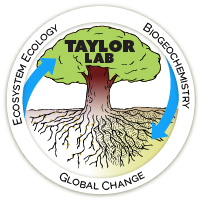Abstract:
Root systems serve important roles in carbon (C) storage and resource acquisition required for the increased photosynthesis expected in CO2-enriched atmospheres. For these reasons, understanding the changes in size, distribution and tissue chemistry of roots is central to predicting the ability of forests to capture anthropogenic CO2. We sampled 8000 cm3 soil monoliths in a pine forest exposed to 14 years of free-air-CO2-enrichment and 6 years of nitrogen (N) fertilization to determine changes in root length, biomass, tissue C : N and mycorrhizal colonization. CO2 fumigation led to greater root length (98%) in unfertilized plots, but root biomass increases under elevated CO2 were only found for roots <1 mm in diameter in unfertilized plots (59%). Neither fine root [C] nor [N] was significantly affected by increased CO2. There was significantly less root biomass in N-fertilized plots (19%), but fine root [N] and [C] both increased under N fertilization (29 and 2%, respectively). Mycorrhizal root tip biomass responded positively to CO2 fumigation in unfertilized plots, but was unaffected by CO2 under N fertilization. Changes in fine root [N] and [C] call for further study of the effects of N fertilization on fine root function. Here, we show that the stimulation of pine roots by elevated CO2 persisted after 14 years of fumigation, and that trees did not rely exclusively on increased mycorrhizal associations to acquire greater amounts of required N in CO2-enriched plots. Stimulation of root systems by CO2 enrichment was seen primarily for fine root length rather than biomass. This observation indicates that studies measuring only biomass might overlook shifts in root systems that better reflect treatment effects on the potential for soil resource uptake. These results suggest an increase in fine root exploration as a primary means for acquiring additional soil resources under elevated CO2.